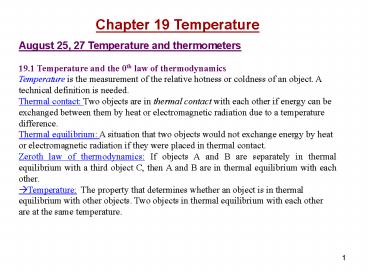Chapter 19 Temperature PowerPoint PPT Presentation
1 / 11
Title: Chapter 19 Temperature
1
- Chapter 19 Temperature
- August 25, 27 Temperature and thermometers
- 19.1 Temperature and the 0th law of
thermodynamics - Temperature is the measurement of the relative
hotness or coldness of an object. A technical
definition is needed. - Thermal contact Two objects are in thermal
contact with each other if energy can be
exchanged between them by heat or electromagnetic
radiation due to a temperature difference. - Thermal equilibrium A situation that two objects
would not exchange energy by heat or
electromagnetic radiation if they were placed in
thermal contact. - Zeroth law of thermodynamics If objects A and B
are separately in thermal equilibrium with a
third object C, then A and B are in thermal
equilibrium with each other. - ?Temperature The property that determines
whether an object is in thermal equilibrium with
other objects. Two objects in thermal equilibrium
with each other are at the same temperature.
2
- 19.2 Thermometers and the Celsius temperature
scale - Thermometer A device that is used to measure the
temperature of a system. - Physical properties of a material length,
volume, pressure, electric resistance, color, - Calibration of thermometers
- Celsius temperature scale ice point 0ºC, steam
point 100ºC.
Problems with liquid-in-glass thermometers 1)
Different thermometers (e.g., mercury and
alcohol) may agree with each other only at the
calibration points. 2) The thermometers have a
limited range of temperatures that can be
measured.
19.3 The constant-volume gas thermometer and the
absolute temperature scale
- Measuring the variation of pressure of a fixed
volume gas as its temperature changes - The volume of the gas is kept constant by raising
or lowering tube B. - The pressure is indicated by the height
difference between tube B and A.
3
- A remarkable point P 0 when TC -273.15ºC
- ?Absolute temperature T TC 273.15
- Absolute temperature scale (Kelvin scale)
- 1) Absolute 0
- 2) Triple point of water 0.01ºC (273.16 K)
- (4.58 mm-Hg).
- 1 K 1/273.16 Temperature of the triple point of
water
Fahrenheit scale ice point 32 ºF, steam point
212 ºF.
Example 19.1
4
Read Ch19 1-3 Homework Ch19 (1-4) 1,3 Due
September 5
5
August 29 Thermal expansion 19.4 Thermal
expansion of solids and liquids Thermal
expansion The increase of the size of an object
with the increase of its temperature. Not always
true. Cause The change in the average separation
between the atoms in an object.
Average coefficient of linear expansion
?Linear expansion
Cavity expands as if were filled. (Free) Thermal
expansion Photographic enlargement
Average coefficient of volume expansion
?Volume expansion
6
For an isotropic material, b 3a
Similarly, for area expansion
Waters unusual behavior The maximum density of
water (1.000 g/cm3) occurs at 4C. This helps to
preserve the lives in water.
Quiz 19.3, 19.4 Example 19.2A, 19.3
7
(No Transcript)
8
Read Ch19 4 Homework Ch19 (5-15) 7,13,15
Due September 5
9
September 3 Ideal gas
19.5 Microscopic description of an ideal
gas Gases Molecular interaction is very week.
There is no equilibrium separation between the
molecules. There is no standard volume at a given
temperature. Equation of state Describing the
relation between the volume V, the pressure P,
and the temperature T of gases. Ideal gas The
gas molecules do not interact except upon
collision. A real gas with low density behaves
approximately as an ideal gas. Mole 1 mole of a
substance contains Avogadros number of particles.
10
Equation of state for an ideal gas (ideal gas
law)
Universal gas constant R8.314 J/molK (in SI)
0.08214 Latm/molK One mole of idea gas at
atmospheric pressure and 0 C is 22.4 L. If n
does not change
Quiz 19.6 Example 19.4
11
Read Ch19 5 Homework Ch19 (26-) 20,24,39 Due
September 12

